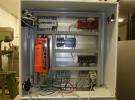I have example code that shows configuring for single ended inputs:
aValues = [ljm.constants.GND, 10.0, 0, 0] # single-ended, +/-10V, 0 (default), 0 (default)
ljm.eWriteNames(handle, len(aNames), aNames, aValues)
So what is the constant to use to specify differential?
And then do I just read the even numbered channels?
I think the LabJack example code could use at least one example of measuring differential input. Or maybe there is something and I couldn't find it.



.png%3Fitok=PHGBxf6M)


.jpg%3Fitok=B1YcuDFK)
.png%3Fitok=Ybt-OlgU)
The NEGATIVE_CH registers for single-ended and differential configuration are documented here in the datasheet:
https://labjack.com/support/datasheets/t-series/ain#differential
So what is the constant to use to specify differential?
For AIN_ALL_NEGATIVE_CH, set it to 1 for all analog inputs to be differential. There is no constant in LJM like with GND. For individual analog input configuration, use AIN#(0:13)_NEGATIVE_CH registers.
And then do I just read the even numbered channels?
Yes, you read the even channels for the differential voltage. For example, reading from AIN2 is the AIN2-AIN3 differential.
Sorry, still a bit confused about setting the negative channel. I'll get specific with an example. Assume I have a Mux80.
Need
* Read AIN64 as single-ended
* Read AIN48 as differential
To achieve this
* Set AIN64_NEGATIVE_CH to 199 (which means GND)
* Set AIN48_NEGATIVE_CH to ???
I want it to be AIN56 per the specifications.
Do I write 56 to explicitly say 56?
Or do I write 1 and then the T7 knows it is 56?
Sorry, I could use more clarification. I am using a Mux80.
If I want to read AIN48 as differential, what do I set AIN48_NEGATIVE_CH to be?
Do I explicitly set it to 56 to say AIN56 is the negative channel?
Or do I set it to 1 and the T7 inherently knows AIN56 is the negative channel?
To set AIN48 to differential, set the negative channel ( AIN48_NEGATIVE_CH ) to 56.
When using the AIN_ALL_NEGATIVE_CH register, a value of 1 will automatically set all AINs to the appropriate negative channel.